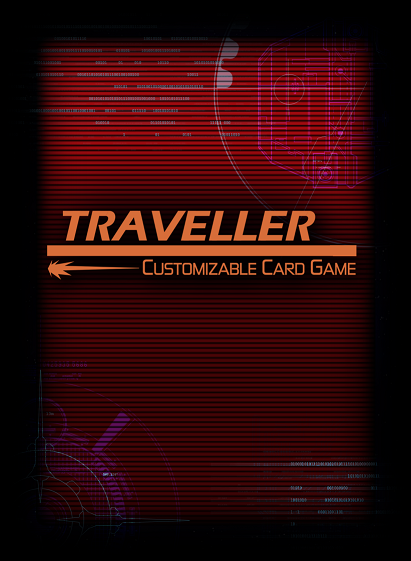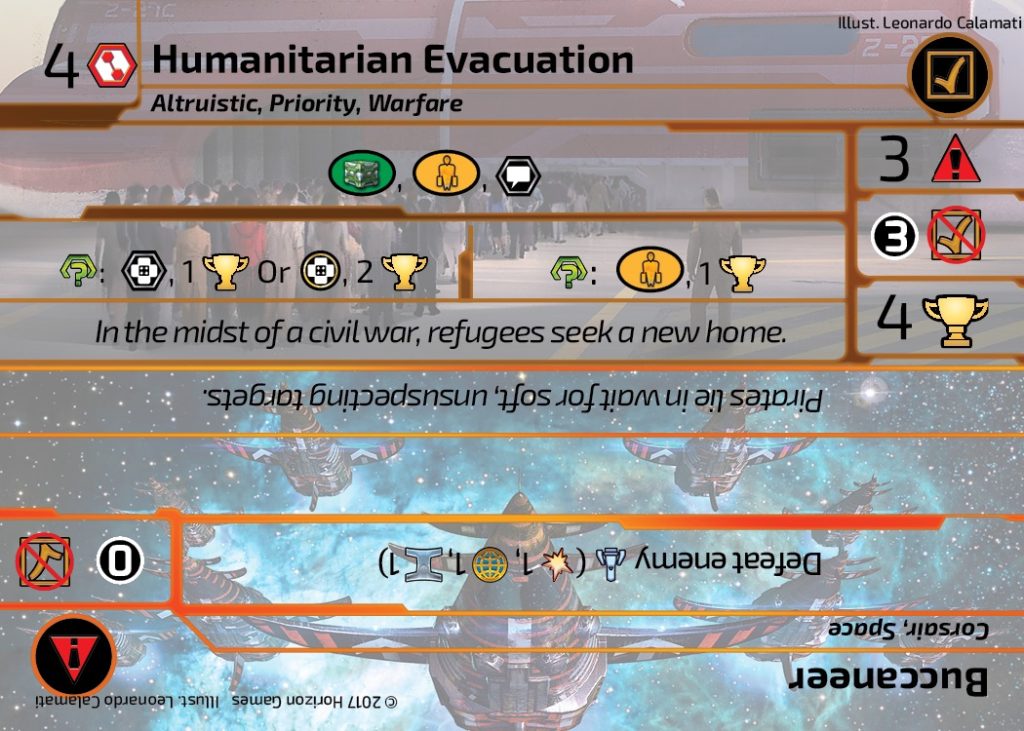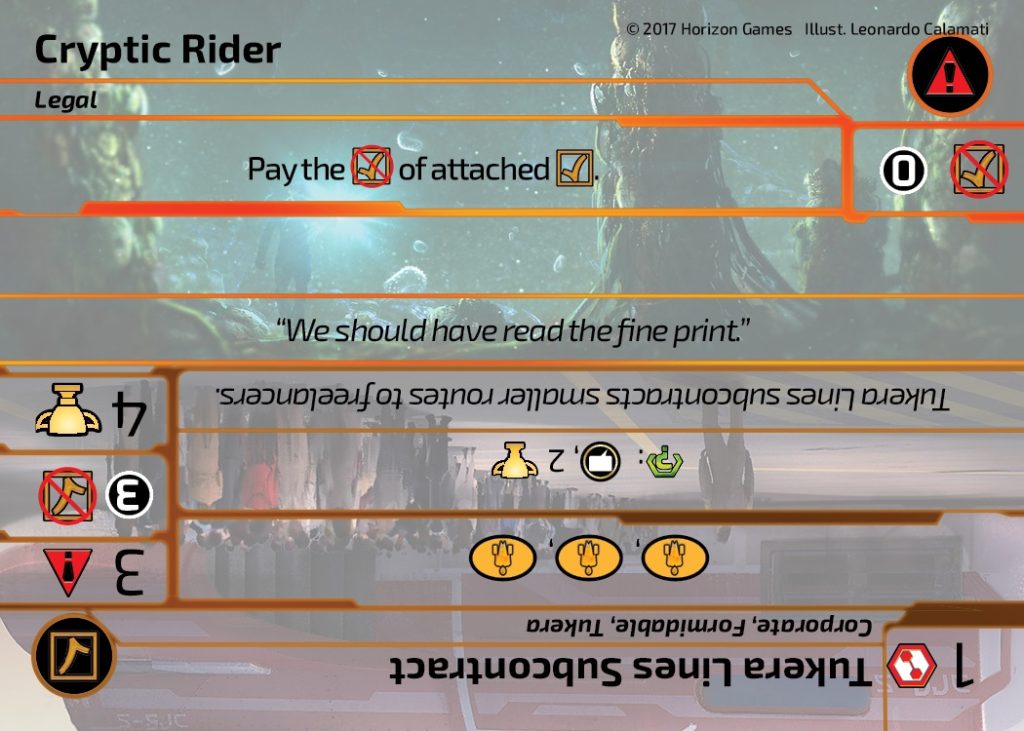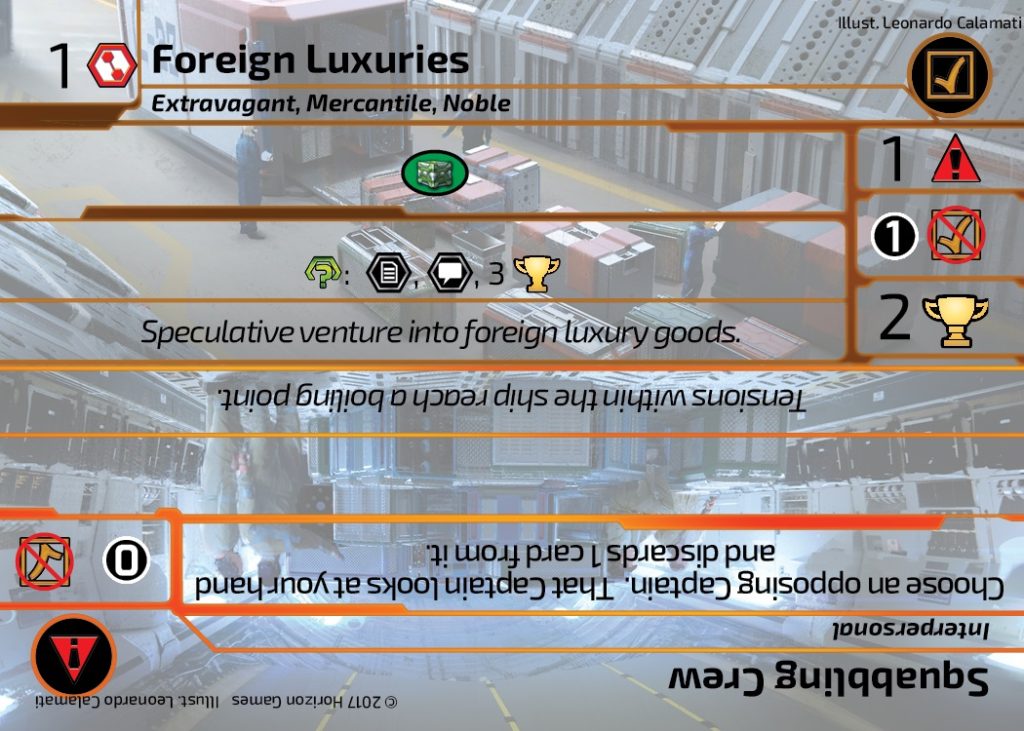Adventure Cards: Dual Use, Multi-Purpose

As lead developer, I focus mostly on detailing mechanics. Starting with this article, I’ll be writing about various topics, giving insight into how the Traveller Card Game evolved, pulling in comparisons with various other games at times, including card games I’ve worked on previously. – Ian Lee
From a role-playing game perspective, adventure cards are both the plots of RPG sessions and the challenges in those sessions. The Adventure deck exists not only to give captains goals but to make those goals challenging. Thus, dual use adventure cards that, in play, are either a contract or a complication.
This feature, which is not common among customizable card games, was built into Traveller from the beginning. Having contracts with specific resource requirements that get more difficult as they remain unfulfilled felt right for how RPG adventures are not about the easy jobs but about the twists and turns that occur in trying to complete them.
The intent with Traveller was to give players two broad paths to victory. Contracts are the intended basic mechanic for earning Victory Points (![]() ), while Piracy facilitates player elimination due to bankruptcy. Adventure cards intersect with these goals in a variety of ways.
), while Piracy facilitates player elimination due to bankruptcy. Adventure cards intersect with these goals in a variety of ways.
Contracts ( )
)
If you peruse the ![]() , it’s clear that there’s a system of having variations on using capabilities and, to a lesser extent, skills to lead to
, it’s clear that there’s a system of having variations on using capabilities and, to a lesser extent, skills to lead to ![]() gains. A single
gains. A single ![]() results in a
results in a ![]() any of the current ships can complete without any additional cards in play. While a
any of the current ships can complete without any additional cards in play. While a ![]() that requires
that requires ![]()
![]() represents a much greater challenge for some vessels, such as the Scout.
represents a much greater challenge for some vessels, such as the Scout.

Complications ( )
)
![]() often require capability or skill tokens, possibly stopping someone who has everything they need to complete the
often require capability or skill tokens, possibly stopping someone who has everything they need to complete the ![]() from scoring
from scoring ![]() this round. On the other hand, some
this round. On the other hand, some ![]() don’t really hinder the ability to complete a
don’t really hinder the ability to complete a ![]() but just make it more costly in
but just make it more costly in ![]() , affecting the attrition rate akin to
, affecting the attrition rate akin to ![]() .
.

Deciding where to place ![]() may seem simple, but it has been our experience that there can be some waffling as to where to put one. In particular, because a full
may seem simple, but it has been our experience that there can be some waffling as to where to put one. In particular, because a full ![]() can have a complication replaced where one below its slot capacity can only gain
can have a complication replaced where one below its slot capacity can only gain ![]() , when to replace has added a lot to our adventure phase decisions.
, when to replace has added a lot to our adventure phase decisions.
Complication Slots
At some point, we changed how Complication Slots were calculated, as we were getting ![]() with too many
with too many ![]() . These overburdened
. These overburdened ![]() just became a waste of time to pursue and the contract field was made less interesting by it. We considered mucking about with the formula of slots based on
just became a waste of time to pursue and the contract field was made less interesting by it. We considered mucking about with the formula of slots based on ![]() but the current system has existed for quite a while.
but the current system has existed for quite a while.
Distance ( )
)
Jump (![]() ) had to be part of the game to make best use of the RPG source material.
) had to be part of the game to make best use of the RPG source material. ![]() almost underwent some major changes but ended up surviving intact.
almost underwent some major changes but ended up surviving intact.
One surprise for me when teaching the game is that ![]() isn’t intuitively obvious to everyone. You have a
isn’t intuitively obvious to everyone. You have a ![]() of 5 and a
of 5 and a ![]() of 2, so you pay
of 2, so you pay ![]()
![]() to jump three times. Maybe it’s other games I’ve played, such as BattleTech, that made this seem obvious – just match your movement rate against your movement requirement.
to jump three times. Maybe it’s other games I’ve played, such as BattleTech, that made this seem obvious – just match your movement rate against your movement requirement.
![]() did have a major change, not in how it worked but in how much it contributed to
did have a major change, not in how it worked but in how much it contributed to ![]() value. Originally,
value. Originally, ![]() were a formula based on number of tokens required with a modifier for
were a formula based on number of tokens required with a modifier for ![]() , but it was producing
, but it was producing ![]() that were too easy to complete for large
that were too easy to complete for large ![]() amounts, so we moved the balancing factor of
amounts, so we moved the balancing factor of ![]() to the
to the ![]() section of the card. The total
section of the card. The total ![]() that someone could gain from a
that someone could gain from a ![]() remained pretty much the same, but high
remained pretty much the same, but high ![]() meant more of a burden was put on having additional skill tokens to spend to max out on
meant more of a burden was put on having additional skill tokens to spend to max out on ![]() .
.
![]() differences affect attrition rate rather than the difficulty of completing a
differences affect attrition rate rather than the difficulty of completing a ![]() . This makes it more subtle, as bankruptcy is far harder to calculate than how many
. This makes it more subtle, as bankruptcy is far harder to calculate than how many ![]() you need to successfully resolve to hit 20
you need to successfully resolve to hit 20 ![]() .
.
Subplots ( )
)
Very early on, we were testing with ![]() that had bonus
that had bonus ![]() for having a skill in addition to the capability requirements. This was a way to get decks to diversify and to produce some greater variance in
for having a skill in addition to the capability requirements. This was a way to get decks to diversify and to produce some greater variance in ![]() gains.
gains.
At first, ![]() were always just +1
were always just +1 ![]() for a specific trained skill. To make later decks different, we started adding
for a specific trained skill. To make later decks different, we started adding![]() that gain more
that gain more ![]() for multiple skills, then moved into the idea of having trained give one bonus and expert another, eventually moving into the world of
for multiple skills, then moved into the idea of having trained give one bonus and expert another, eventually moving into the world of ![]() having multiple
having multiple ![]() . The sophistication level with this one feature of the game expanded immensely.
. The sophistication level with this one feature of the game expanded immensely.
Another notable moment in development with ![]() was when we were trying to fix the balance on one specific
was when we were trying to fix the balance on one specific ![]() and got into a discussion of moving
and got into a discussion of moving ![]() from
from ![]() to
to ![]() . While we decided we didn’t like removing
. While we decided we didn’t like removing ![]() from
from ![]() entirely, we did realize there was nothing keeping us from having some
entirely, we did realize there was nothing keeping us from having some ![]() with no
with no ![]() and having some
and having some ![]() with
with ![]() . We plan on publishing significantly more
. We plan on publishing significantly more ![]() with
with ![]() , possibly pretty soon.
, possibly pretty soon.

Deckbuilding
What are some considerations for which adventure cards to include in your adventure deck?
Contract or Complication
Do you care more about your ability to complete the ![]() or do you care more about the impact of the
or do you care more about the impact of the ![]() side?
side?
Maybe both. Including a bunch of contracts requiring ![]() in a Beowulf deck is probably not going to move you toward victory and may make a Scout opponent’s game much easier. However, the easy
in a Beowulf deck is probably not going to move you toward victory and may make a Scout opponent’s game much easier. However, the easy ![]() based
based ![]() may have
may have ![]() that will slow you down quite often.
that will slow you down quite often.
If your plan is to focus on Piracy and bankrupting your opponent, the topic becomes even more interesting. ![]() with high
with high ![]() and/or automatic
and/or automatic ![]() hit
hit ![]() are clear ways to increase the opponent’s attrition rate. I may follow up on adventure cards for Piracy decks as there are some other interesting considerations, or it may be that you all discover them on your own …
are clear ways to increase the opponent’s attrition rate. I may follow up on adventure cards for Piracy decks as there are some other interesting considerations, or it may be that you all discover them on your own …
Big or Fast
The more ![]() you can get from a
you can get from a ![]() , the fewer rounds it may take you to win. On the other hand, low requirement
, the fewer rounds it may take you to win. On the other hand, low requirement ![]() may get you to the finish line faster because you can reliably complete one each round.
may get you to the finish line faster because you can reliably complete one each round.
Sometimes, you get the right cards in play and you get a lot of ![]() fairly easily, hitting the ideal of both big and fast. One deck archetype that was popular in testing was the Scout/
fairly easily, hitting the ideal of both big and fast. One deck archetype that was popular in testing was the Scout/![]() /
/![]() deck that could gain a lot of
deck that could gain a lot of ![]() from
from ![]() with
with ![]() and
and ![]() themed
themed ![]() .
.

